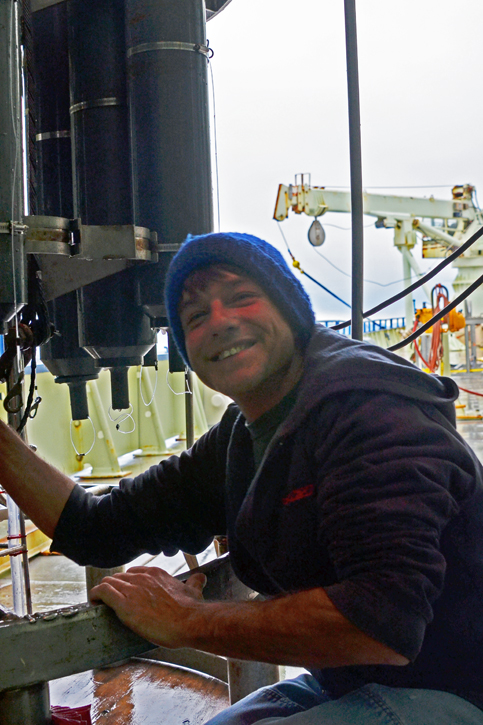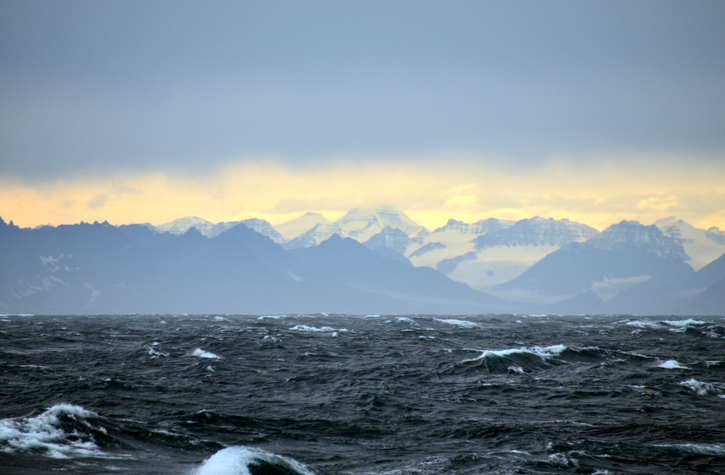September 3, 2011Anton Zafereo, one of the two Shipboard Science Support Group (SSSG), worked through the night (with Catie Graver, the other SSSG, right beside him every step of the way) to repair the flooded pressure sensor, which records the depth at which the CTD is logging temperature and salinity data. That data is useless if there’s no accurate depth to accompany it. None but the most senior shoreside technicians at SeaBird, the manufacturer, ever disassemble the pressure sensor for service. Anton talked with SeaBird experts by sat phone; they warned him that if he disassembled the unit, he might never get back together again, at least not so it worked. But there was no choice and nothing to lose, so Anton went at it.
A spare sensor package is being flown to Akureyri, Iceland’s second largest town, on the north coast, but it won’t arrive until Tuesday. We’re going to go get it in any case—it’s too risky to be without a spare for obvious reasons—but had Anton been unable to fix this one, science operations would have been crippled, three precious days lost, gone. A knot of people stood tensely around the CTD computer console this morning watching the progress of the first post-repair cast. The package passed 900 meters. The pressure sensor was working flawlessly. Now instead of losing three days, Bob and Kjetil can complete this line, which ends near Greenland, then pick up another north of Iceland on the way to Akureyri. We’ve seen Bob remain cool in the face of oceanographic fire before, when heavy weather blew out an entire week and more, when gear broke or was stolen by the subject of his study. It happens to everyone who studies the sea at sea, but perhaps not everyone takes it so evenly. And he’s genuinely and vocally appreciative when rescued from loss of time and gear by crew and techs. And this includes the CTD watches who’ve been deploying and recovering the package while boarding seas come over the bulwarks and slosh around their legs. He’s the paradigmatic sea-going oceanographer, in my opinion, and I’m not alone in that view aboard this boat. * * * This blow, same old remnants of Hurricane Irene, is doing just as forecast—hanging around all day yesterday and today, blowing up periodically into the high forties from their mean in the mid-thirties and making for a really nasty motion. When we steam between CTD stops, she takes on this corkscrew motion, because we’ve been heading almost due west, while the wind is honking out of the northeast. (I’m holding on with one hand and typing with the other; I’m not alone in that either.) Perhaps you remember my mentioning those barrier winds created when a cyclonic low encounters the high coast of Greenland, and the mountains act to accelerate the wind velocity. Bob just told me we’re experiencing that very phenomenon right now. How he knows that reveals another fascinating physical act of nature. “I’m recording downwelling,” he said. When wind blows over the surface of the sea, hauling water along with it, the force of Earth’s rotation bends the water to the right in the Northern Hemisphere (to the left in the other one.) So when the northerly winds blow down the mountainous coast of East Greenland, the water tries to bend rightward, that is, inshore. But it can’t, at least not for long—because the coast is in the way. However the water has to go somewhere. So it flows down, and then offshore along the bottom. Bob has seen the fingerprint in the CTD data of cold, fresh water from the East Greenland Current, which remains normally on the Greenland shelf, out in deeper water well away from the shelf. This is downwelling. Without the barrier winds, this would not happen.
Barrier winds: 55 knots overnight. © Rachel Fletcher Okay, I’ve had it for today. This motion is getting to me. Things are falling and bouncing around the boat as if with a malicious mind of their own. My eyes are spinning, along with my stomach. Good night. Last updated: December 27, 2011 | |||||||||||||
Copyright ©2007 Woods Hole Oceanographic Institution, All Rights Reserved, Privacy Policy. | |||||||||||||




